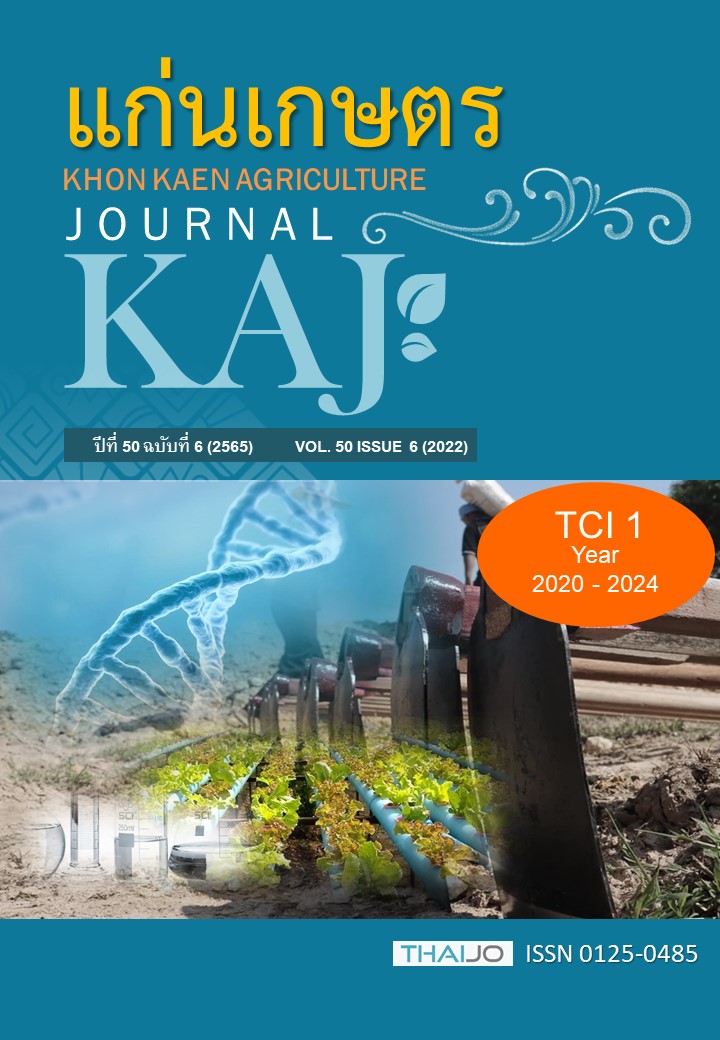ผลของอาหารต่อการเจริญเติบโต การวางไข่ และคุณภาพของแมลงโปรตีน, Hermetia illucens L. (Diptera: Stratiomyidae)
Main Article Content
บทคัดย่อ
แมลงโปรตีนมีประสิทธิภาพในการกินและเปลี่ยนเศษเหลือทิ้งอินทรีย์ที่กินให้เป็นมวลชีวภาพที่มีโปรตีนและไขมันสูง สามารถนำไปใช้ในอุตสาหกรรมอาหารสัตว์ การวิจัยนี้มีวัตถุประสงค์เพื่อศึกษาผลของเศษเหลือทิ้งอินทรีย์ต่อการเจริญเติบโต การวางไข่ของแมลงโปรตีน และคุณภาพของระยะก่อนเข้าดักแด้ (prepupa) วางแผนการทดลองแบบสุ่มสมบูรณ์โดยใช้อาหารเลี้ยงแมลงมี 4 กรรมวิธีๆ ละ 5 ซ้ำ แต่ละซ้ำใช้แมลง 200 ตัว ได้แก่ 1) กลุ่มควบคุม คือ กากเบียร์ผสมกากเนื้อในปาล์ม 2) กลุ่มโปรตีน คือ เศษอาหารผสมผักผลไม้ผสมกากเบียร์ 3) กลุ่มไขมัน คือ เศษอาหารผสมผักผลไม้ผสมหนังไก่ และ 4) กลุ่มเยื่อใย คือ เศษอาหารผสมผักผลไม้ผสมชานอ้อยหมัก ผลการศึกษาพบว่า อาหารทั้ง 4 กลุ่ม มีผลต่อระยะ prepupa มีค่าโภชนสาร ที่มีโปรตีนร้อยละ 44-46 และไขมันร้อยละ 21-26 โดยอาหารกลุ่มโปรตีนให้ระยะ prepupa ที่มีโปรตีนมากที่สุดร้อยละ 46 มีน้ำหนัก prepupa 0.17 ก./ตัว มากกว่าที่เลี้ยงด้วยกลุ่มเยื่อใย (0.15 ก./ตัว) ซึ่งแตกต่างอย่างมีนัยสำคัญยิ่งทางสถิติ (P≤0.01) ระยะตัวหนอนมีการเจริญเติบโตรวดเร็ว ใช้เวลาสั้น 16.73 วัน การรอดชีวิตของตัวหนอนสูงร้อยละ 95.50 สัดส่วนเพศผู้ต่อเพศเมีย 0.85 : 1 ส่วนกลุ่มอาหารที่ไม่เหมาะสม คือกลุ่มไขมัน ถึงแม้ว่าจะได้น้ำหนัก prepupa สูงที่สุด 0.18 ก./ตัว แต่การรอดชีวิตของระยะตัวหนอนน้อยที่สุดร้อยละ 63.80 และตัวหนอนใช้ระยะเวลาในการเจริญเติบโตนานที่สุด 22.45 วัน แตกต่างอย่างมีนัยสำคัญยิ่งทางสถิติ (P≤0.01) กับกลุ่มอื่น ๆ สรุปได้ว่าอาหารที่เหมาะสมในการเลี้ยงแมลงโปรตีน คืออาหารกลุ่มโปรตีน ซึ่งพิจารณาจากระยะตัวหนอนมีการเจริญเติบโตรวดเร็ว การรอดชีวิตของตัวหนอนมากที่สุด มีผลผลิตน้ำหนักรวม prepupa มาก ได้สัดส่วนเพศเมียมากกว่าเพศผู้ และมีต้นทุนการผลิตต่ำเพียง 1.80 บาทต่อการผลิต prepupa 1 กก.
Article Details

อนุญาตภายใต้เงื่อนไข Creative Commons Attribution-NonCommercial-NoDerivatives 4.0 International License.
เอกสารอ้างอิง
กรมการค้าภายใน กระทรวงพาณิชย์. 2565. ราคาปลาป่นและปริมาณนำเข้า-ส่งออก. แหล่งข้อมูล: https://agri.dit.go.th/index.php/. ค้นเมื่อ 18 มีนาคม 2565.
กุลชาติ บูรณะ และทัศนีย์ แจ่มจรรยา. 2552. การแพร่กระจาย การเพาะเลี้ยงและคุณคาทางโภชนะของแมลงวันลาย (Hermetia illucens L.). น.603-609. ใน : การประชุมวิชาการเสนอผลงานวิจัยระดับบัณฑิตศึกษา ครั้งที่ 11 มหาวิทยาลัยขอนแก่น, ขอนแก่น.
ศูนย์ข้อมูลเกษตรแห่งชาติ. 2564. ข้อมูลปริมาณการผลิตปาล์มน้ำมัน ปี 2564. แหล่งข้อมูล: http://thaisdi.gistda.or.th/dataset/oae15_04/resource/4900a74b-279d-4cf2-bc39-270e546b61b5. ค้นเมื่อ 16 มีนาคม 2565.
สำนักเลขาธิการคณะรัฐมนตรี. 2564. แผนปฏิบัติการลด และคัดแยกขยะมูลฝอย สำนักเลขาธิการคณะรัฐมนตรีประจำปีงบประมาณ พ.ศ. 2564. แหล่งข้อมูล: https://www.soc.go.th/wp-content/uploads/2021/02/garbage2564.pdf. ค้นเมื่อ 7 กุมภาพันธ์ 2565.
Banks, I.J., W.T. Gibson, and M.M. Camero. 2014. Growth rates of black soldier fly larvae fed on fresh human faeces and their implication for improving sanitation. Tropical Medicine and International Health. 19:14-22.
Barragán-Fonseca, K, J. Pineda-Mejia, M. Dicke, and J.J. Van Loon. 2018. Performance of the black soldier fly (Diptera:Stratiomyidae)on vegetable residue-based diets formulated based on protein and carbohydrate contents. Journal of Economic Entomology. 111(6): 2676-2683.
Bava, L., G. Gislon, M. Zucali, S. Colombini, C. Jucker, D. Lupi, and S. Savoldelli. 2019. Rearing of Hermetia Illucens on different organic by-products: Influence on growth, waste reduction, and environmental impact. Journal Animals. 289 (9): 1-16.
Diener, S., C. Zurbrügg, F. Roa Gutiérrez, D.H. Nguyen, A. Morel, T. Koottatep, and K. Tockner. 2011. Black soldier fly larvae for organic waste treatment – prospects and constraints, pp. 52 (1-8). Proceedings of the Waste Safe 2011 – 2nd International Conference on Solid Waste Management in the Developing Countries 13-15 February 2011, Khulna, Bangladesh.
Devendra, C., and R.N. Muthurajah. 1976. The utilization of palm oil by-products by sheep, pp 21. International Symposium on Palm Oil Processing and Marketing 17-19 June 1976. Kuala Lumpur, Malaysia.
Gobbi, P., A. Martinez-Sanchez, and S. Rojo. 2013. The effects of larval diet on adult life-history traits of the black soldier fly, Hermetia illucens (Diptera: Stratiomyidae). European Journal of Entomology. 110(3): 461-468.
Hem, S., S. Toure, C. Sagbla, and M. Legendre. 2008. Bioconversion of palm kernel meal for aquaculture: experiences from the forest region (Republic of Guinea). African Journal of Biotechnology. 7(8): 1192-1198.
Hoc, B., G. Noël, J. Carpentier, F. Francis, and R.C. Megido. 2019. Optimization of BSF artificial reproduction. PLoS One. 14(4): 1–13.
Jucker, C., M.G. Leonardi, I. Rigamonti, D. Lupi, and S. Savoldelli. 2019. Brewery’s waste streams as a valuable substrate for black soldier fly Hermetia illucens (Diptera: Stratiomyidae). Journal of Entomological and Acarological Research. 8876 (51): 87-94.
Jucker, C., D. Lupi, C.D. Moore, M.G. Leonardi, and S. Savoldelli. 2020. Nutrient recapture from insect farm waste: Bioconversion with Hermetia illucens (L.) (Diptera: Stratiomyidae). Journal Sustainability. 362 (12): 1-14.
Lalander, C., S. Diener, M.E. Magri, C. Zurbrügg, A. Lindström, and B. Vinnerås. 2013. Faecal sludge management with the larvae of the black soldier fly (Hermetia illucens) from a hygiene aspect. Science of the Total Environment. 458: 312-318.
Mohammed, D., D. Addis, T. Berhanu, and A. Vernooij. 2019. Mapping of spent brewers’ grain supplychain in Ethiopia. Wageningen Livestock Research. report No. 1210.
Myers, H.M., J.K. Tomberlin, B.D. Lambert, and K. David. 2008. Development of black soldier fly (Diptera: Stratiomyidae) larvae fed dairy manure. Environmental Entomology. 37: 11–15.
Newton, L., C. Sheppard, D. W. Watson, G. Burtle, and R. Dove. 2005. Using the black soldier fly, Hermetia illucens, as a value-added tool for the management of swine manure. Animal and Poultry Waste Management Center. North Carolina State University. 17: 1-18.
Nguyen, T.T.X., J.K. Tomberlin, and S. Vanlaerhoven. 2015. Ability of black soldier fly (Diptera: Stratiomyidae) larvae to recycle food waste. Environmental Entomology. 44 (2): 406–410.
Oonincx, D.G., S. Van Broekhoven, A. Van Huis, and J.J. Van Loon. 2015. Feed conversion, survival and development, and composition of four Insect species on diets composed of Food By-Products. PLoS ONE. 10 (12): 1-20.
Sheppard, D.C., G.L. Newton, S.A. Thompson, and S. Savage. 1994. A value-added manure management-system using the black soldier fly. Bioresource Technology. 50: 275–279.
Spranghers, T., M. Ottoboni, C. Klootwijk, A. Ovyn, S. Deboosere, B. Meulenaer, J. De Michiels, M. Eeckhout, P. De Clercq, and S. De Smet. 2017. Nutritional composition of black soldier fly (Hermetia illucens) prepupae reared on different organic waste substrates. Journal of the Science of Food and Agriculture. 97 (8): 2594-2600.
Tschirner, M., and A. Simon. 2015. Influence of different growing substrates and processing on the nutrient composition of black soldier fly larvae destined for animal feed. Journal of Insects as Food and Feed. 1(4): 249-259.
Wang, Y.S., and M. Shelomi. 2017.Review of black soldier fly (Hermetia illucens) as animal feed and human food. Foods. 91(6): 1-23.
Yurina, O.V., and V.P. Karagodin. 2018. Studying development of Hermetia illucens fly larvae cultivated on high cellulose plant substrates. Bulgarian Journal of Agricultural Science. 24 (2): 279–284.


